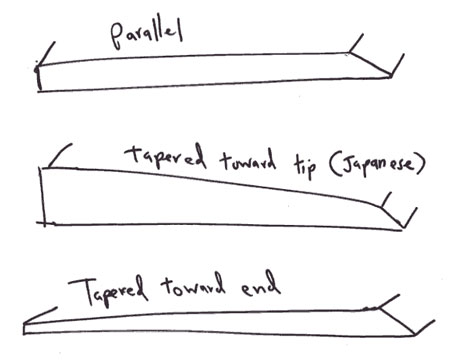| | 03/25/2010 | 
Last week I wrote about my cracked iron and a desire for a tapered iron for my miter plane and J asked the following question:
I got similar queries from a few other people and the answer deserves a proper explanation:
A plane iron can be parallel, tapered so that the thick end is near the mouth, or tapered so that the thinner end is near the mouth (See picture).
If the iron is parallel the iron will stay put provided the force on the iron is less than the wedge force or the frictional force caused by the wedge bearing down on the iron. In general the friction force is going to be a lot less than the wedge force and depending on the iron and the fit of the wedge (very important) you might have to bang the wedge in pretty hard to keep the frictional force high enough so the iron stays put in use. The same force is needed to slide the iron in or out.
Japanese planes have a tapered iron with the cutting edge at the thin end. The iron is held by wedging it into notches at the side of the plane and it's the grain of the oak body that keeps the iron in place. This method of holding an iron in a plane is completely different from the Western approach.
The Western tapered iron is thicker at the cutting edge and works well because the iron is held in place by a mechanical interference between iron and wedge. There is no chance of the iron sliding so the force holding the iron in is purely a taper against the body of the plane, not parallel to the iron and is very strong. Most importantly the forces required to back off the iron are far greater than the force required to advance the iron. So a tap, tap on the back of the iron will advance the iron, and only a small tap on the wedge will lock it. Pushing back the other way takes more force. Try this and see - how hard it takes to advance a tapered iron vs the force needed to back it out.
Wedged infill planes pretty much disappear after the invention of the lever cap by Fenn in 1844. This allowed for using less expensive parallel irons, and it is far easier to fit a lever cap to a plane than a wedge. However I think adjusting a wedged plane is far easier. This changes again in 1913 when Norris introduced their adjuster. There is also an argument that a properly fitting wedge helps dampen vibration by clamping the iron over a much greater area than a lever cap. I want to think this is true but the thicker the plane iron is the less effect the wedge dampening would have.
| Join the conversation | |
| The opinions expressed in this blog are those of the blog's author and guests and in no way reflect the views of Tools for Working Wood. |
|
 Joel's Blog
Joel's Blog Built-It Blog
Built-It Blog Video Roundup
Video Roundup Classes & Events
Classes & Events Work Magazine
Work Magazine



Is there? Surely not. All my wedged planes are cut out in the middle and only wedge tightly at the edges, where the wedge also bears against the plane body.
All my steel planes are clamped centrally by the lever cam, the force being distributed right across the width by the lever cap bearing down on to the cap iron. This is helped by the heavy construction of the lever cap.
All in all a brilliant design - also permitting the use of thinner (hence more easily honed) blades which must have saved millions of man-hours since it's inception.
Around here (Australia), older tapered irons, are far more plentiful than parallel, mostly Mathieson for some reason.
Thank you
David